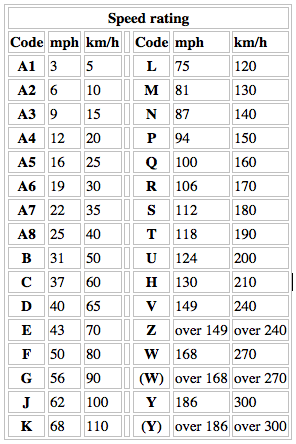Service descriptions are required on all speed rated (except for Z- speed rated) tires manufactured. This is good information to have for a number of reasons, some of which actually include the likelihood of you ever being able to sustain. Understanding tire service description, load rating, and speed rating. If you look at the sidewall of a tire, you’ll see a whole slew of characters and numbers. A higher speed rating usually means you will have better control and handling at higher speeds — and that the tire can take the extra heat.

The speed rating tells you the speed the tire can safely maintain over time. As a general rule, tires with higher speed ratings also handle better at slower speeds. We can thank Germany’s famous Autobahn for tire speed ratings. But the chart is not completely in alphabetical order.
For example, H is between U and V, with the common perception that H stood for “high performance” at one time. The tire load index lets you know the load carrying capacity of a tire. In other words, it’s the amount of weight your tire can support safely. For example, if a tire has a load index of 9 it can support 3pounds at maximum air pressure. What is the tire speed index?
How do you calculate tire speed? Free 2-day Shipping On Millions of Items. Never try to second-guess the designers and engineers with regards to tire size, type, speed or load rating ! Use the information on this page for general reference only and not for.
Start with tire pressure recommended for normal driving conditions, and as speed increases, initially so does the tire inflation. When tire inflation reaches its maximum allowed then tire load capacity is reduced as speed climbs. Once the highest speed rating a tire could have, “V” used to represent a maximum of 1mph (2kph) or more.
Nowadays, it means 1mph but no higher. A relatively new addition to the speed rating chart , tires with speed rating “W” can achieve a maximum sustained speed of 1mph (2kph). It’s your tire speed rating , or, to be more accurate, your tire ’s performance rating. People refer to that last letter of the tire size on the sidewall of your tires as ‘ tire speed rating ’—the maximum speed a tire can sustain for a certain period of time without risk of tire failure.
But it’s not just about speed. Every tire approved for highway use by the Department of Transportation, including those on your vehicle, comes with a particular speed rating. You can always increase the speed rating of the tires on your vehicle for improved performance, but can never decrease it without reducing the vehicle top speed to that of the lower speed rating selected.
Browns Alignment Brake Auto Repair, Raleigh, NC. A speed rating isn't, however, a recommendation to exceed speed limits, and doesn't indicate how well a tire handles or corners. Choosing tires with the right speed rating ensures proper handling and smooth car functioning.
A chart denoting tire speed rating codes is an essential reference when buying new wheels for your automobile. Generally speaking, touring tires with lower speed rating (S, T or H ratings on the sidewall) are optimized for more comfort instead of more speed – it's recommended to never go below the speed rating specified by the manufacturer of your vehicle. Tire Speed Rating Chart.
No comments:
Post a Comment
Note: Only a member of this blog may post a comment.